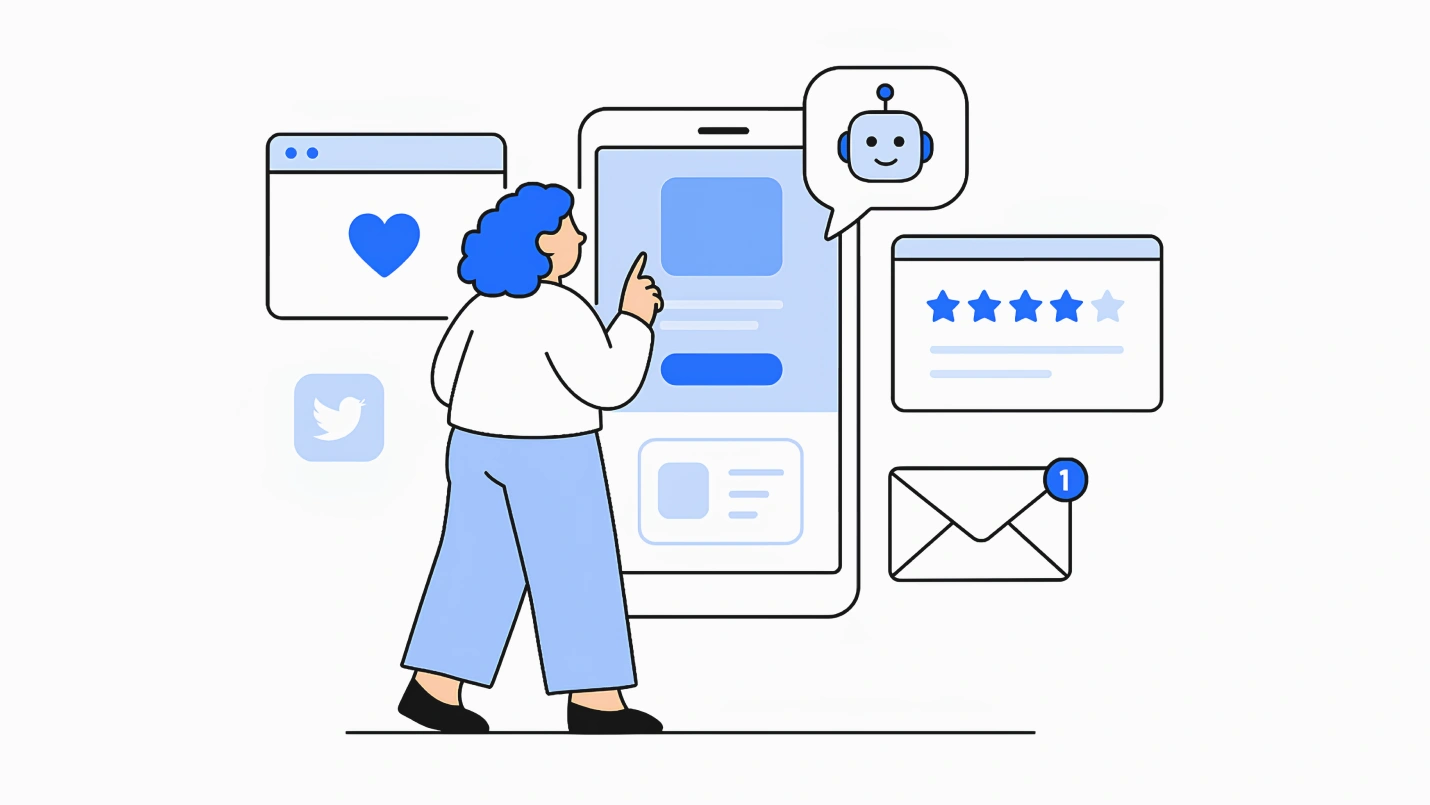Summary: A flawless digital customer experience is essential to keep customers returning and boost conversions. However, there’s much more to digital customer experience than a few tips and practices. To deliver an immersive experience to our customers, we need to understand what it takes to offer a digital experience to customers from scratch. Read on to learn about digital customer experience, why it matters to your business, and some of the best digital customer experience practices you can follow.
Today’s channel-agnostic consumers demand timely, relevant, consistent, and personal “phygital” (physical + digital) experience throughout all touchpoints and value creation stages. However, CRM alone cannot drive that kind of experience — close to 70% of CRM projects fail — it encapsulates only a limited amount of consumer data.
CXM (Digital Customer Experience Management) is an action-driven insights solution that ensures a more optimal and orchestrated customer experience in real-time across multiple channels.
Over 90% of business leaders claim that CXM creates “loyal customer relationships” and delivers “the brand promise.”
What is a digital customer experience?
Digital customer experience refers to all customer interactions with your brand. An example of this can be a prospect visiting your website, interacting with your brand on social media, reading an email, or even using the mobile app.
A digital customer experience is measured as a whole, and what matters, in the end, is the perception customers take away about your brand. So, here are a few questions you must ask yourself to ensure you get the digital customer experience right:
- How is it to place an order on a website or fill out a contact form? Is it bothersome or smooth?
- How much time does it take for your website to load?
- How do you come across on social media? Do you respond to questions on time and respond to comments?
- How often do customers open your emails? Do they frequently unsubscribe to your newsletters?
Why is Digital Customer Experience Important?
The Customer journey is complex for businesses. They have to navigate shoppers through multiple channels before they buy from them.
However, for customers, the journey is simple. They hardly differentiate between offline and online, owned and non-owned, marketing and eCommerce. Hence, they expect you to navigate these channels without hassle or change in the shopping experience.
A digital customer experience or a digital experience solution ensures that customers can seamlessly move between touchpoints without experiencing any bottlenecks. Regardless of where the customer finds you, e.g., on your website, app, or social media, you must have a consistent presence that guides them smoothly throughout their buying journey.
Besides, a seamless digital customer experience helps both customers and businesses. A Harvard Business study found that omnichannel customers are more valuable as they spend 4% more in-store and 10% on the eCommerce website. Also, these customers are more likely to stick around. Research shows that strong omnichannel customer engagement retains 89% of customers on average, while companies with weak strategies can only retain 33% of customers.
Best practices for creating a seamless digital customer experience
So you learned what digital customer experience is and why it is essential for businesses and customers. But how to create a seamless digital customer experience that makes customers buy from you? Let’s find out:
1. Understand the why and how of digital customer experience
Here are two essential components that decide a brand’s digital customer experience:
- Experience data that measures the attitude, emotions, and intentions of your customers. For example, relational feedback, journey-based feedback, natural speech and text, and passive listening. It helps you understand the why behind your customer behavior.
- Operational data that is observable and derived from objectives. For example, Customer Relationship Management data, sales stats, website traffic, contact wait times, etc. It only helps you understand what happened on your eCommerce Platforms.
Both operational and experience data are helpful for user experience management. However, when you combine them, they become a powerful tool that helps you gain complete insights into customers’ activities, insights, wants, and intentions while keeping an eye on the competition.
Hence, you must understand the why and how of customer experience and strive to create the right mix of both. This way, you can build a uniform digital customer experience that offers you a competitive edge in all aspects.
2. Study your key customer journeys in depth
Touchpoints are the key elements of the digital customer experience. Hence, you must spend a lot of time studying them. Primarily focus on high-stake touch points like checkout and payments, visiting your online store for the first time, or creating an account.
Carefully analyze how customers feel at these touchpoints, i.e., do they enjoy the experience or feel stuck? It would provide much-needed insights about customer experience and improve anything that becomes a hurdle.
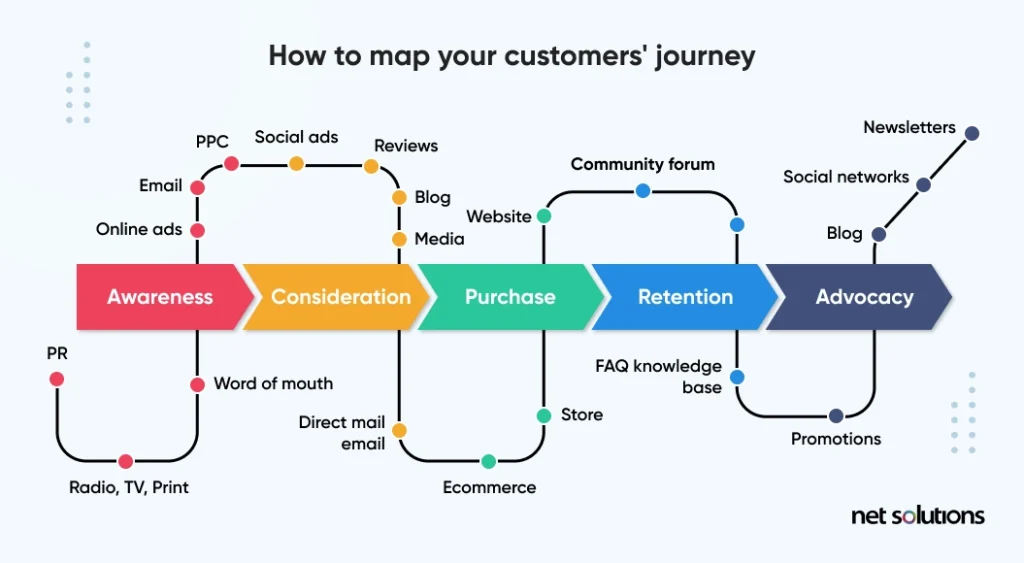
3. Identify your target audience
One of the best ways to build a unique and uniform digital customer experience is to gather feedback from the right audience. It would ensure you don’t get distracted and deliver products or services tailored to their business needs.
To identify the right target audience for feedback, look for customers who frequently shop from you across multiple channels, such as your website, app, or social media. Observe their experience and see what pain points they encounter. Such people can tell much about improving your brand’s digital customer experience.
4. Offers users easy ways to provide feedback

Feedback is crucial in digital customer experience management. But if you make your audience work too hard for it, they might quickly jump ship. Hence, you must offer customers an easy way to provide feedback. You can provide a form of some sort, a star-rating interface, or a chat function. It would ensure you can meet your customers where they are, and they can directly talk to you.
5. Start with tracking & diagnosing potential high-level problems
Customer experience management is a journey that takes time, not a 100-meters sprint that you need to finish as soon as possible. When you try doing too many things at once, you often make things worse instead of fixing them. A much wiser approach is to start from one step and then progress further as you get the hang of things.
An ideal beginner step is determining the most common customer journeys and broad problems customers face. It would help you see what’s keeping users on your website, their end goal, and how likely they will return to it. It would also help you establish baseline metrics to track your progress.
6. Keep an eye on the latest trends
Digital customer experience management is an evolving field. What is an ideal customer experience today may be better tomorrow. Hence, it’s essential to keep an eye on the latest digital customer experience management trends and analyze what you can implement to offer a unique digital experience design to your customers.
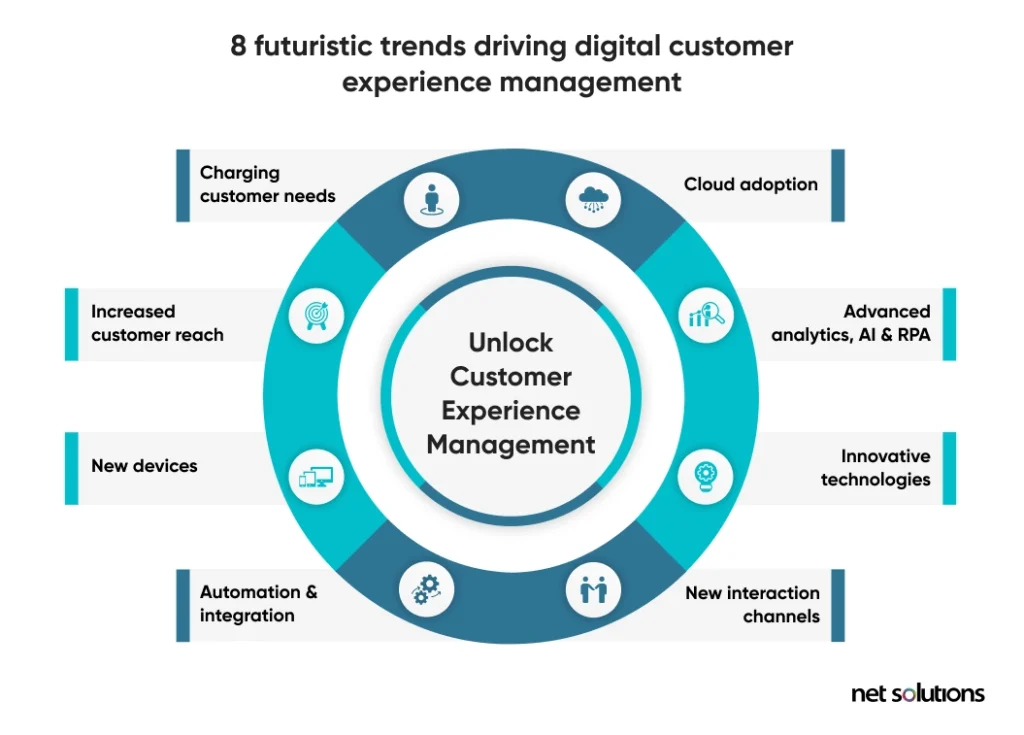
7. Choose the right digital experience platform
Digital customer experience management is complex. Studying all the touch points, analyzing all the data, and predicting insights will become a nightmare if you decide to do everything independently. Hence, investing in a digital customer experience design agency and platform that takes care of all these things for you is wise.
Here’s what to look for in a digital experience platform if you’ve decided to buy one:
- Real-time reporting: Accurate moment-to-moment details on both experience and operational data. Also, there should be a user-friendly dashboard to monitor various micro-level trends.
- User role profiles and permissions: The digital experience platform should allow you to define various roles and grant permissions accordingly. It would make everything easy for you.
- Automated actions: An automated system that allows you to pre-set tickets and alerts. It saves time and effort by altering your team on time and taking care of mundane tasks.
- Integration: You can manage digital customer experience more efficiently when you integrate the digital experience platform with tools you’re already using, such as social platforms, websites, ERP software, CRM, etc.
- Active support: The digital experience platform must offer you the much-needed support to help when things don’t go right.
- One-stop shop: The digital experience platform must offer everything you need to provide seamless customer experience management
Digital Customer Experience Management (CXM) Strategy
Becoming an experience-driven business demands an orchestration of customer experiences involving a top-down, cross-organization approach with the key roles of the entire C-suite — CMOs, CROs, CDOs, CIOs, and other customer-facing teams.
A Forrester ROI study mentions that a successful CXM strategy leads to 1.7x higher customer retention rates, 1.6x customer lifetime value, and 1.4x revenue growth.
A great CXM strategy rests on three critical pillars, which can help a business build a customer experience journey from start to finish, pushing it a step closer to digital transformation.
1. Data-Driven Insights
A successful CXM strategy demands all data be placed in one place, available in real-time so that it can be leveraged to make informed decisions on what to present next — delivering the same information with every interaction ends up in a repetitive, redundant and frustrating customer experience.
“You may have millions of customers, but you must know them like they’re your only customer.” – Adobe CEO Shantanu Narayen.
To achieve this seemingly impossible task, Digital Customer Experience Management helps weave all potential consumer data together on a single platform and develop a unified profile to enable marketers to watch their customers in real-time, thereby building relevant experiences to match their expectations, which is critical to the success of your CXM strategy.
However, the three most important parameters to keep in mind in gathering customer data are security (DevSecOps), trust, and transparency. Your target customers should be aware of when and how their data is being collected and used — made clear upfront in plain, easy-to-understand language.
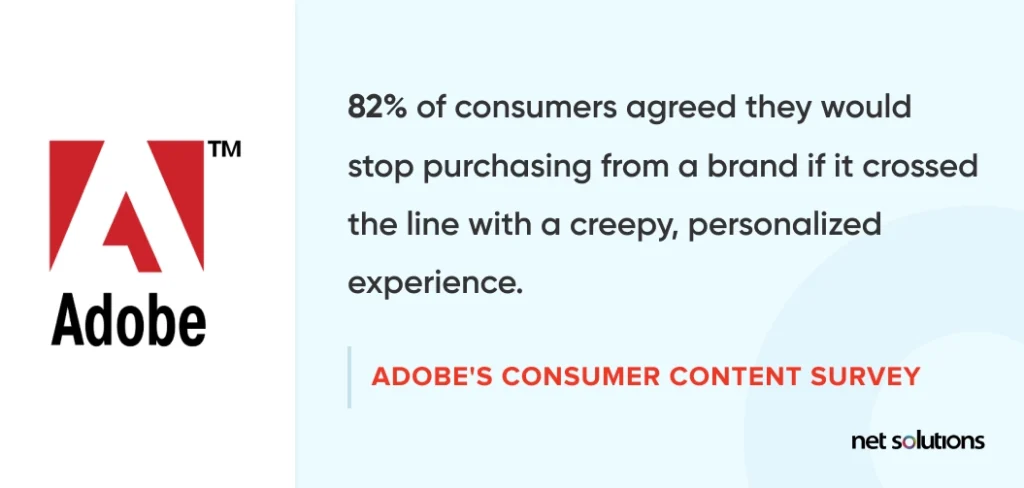
2. Orchestration of Multiple Channels
Digital ecosystem orchestration is accelerated in the hyper-connected digital world. The real challenge is to understand where and how you can and should improve to get the biggest effect and scale-up across the digital ecosystem effortlessly. – Digital Masters
What would be your next step if your potential customer in the middle of the funnel isn’t responsive to one message or one channel? An ideal move would be to send the following relevant and personalized message through a different channel.
With an orchestrated experience, you build, deliver, connect, and manage unique customer experiences across multiple channels and devices to keep a singular voice — shaped, targeted, and timed based on previous customer interactions — across channels, markets, and languages.

3. Intelligence
Acquiring customer data — the raw material is the first step, and analyzing it comes next. While CRM talks about a “360-degree view of customers,” they cannot always gather data into a single environment — acting on fragments of the customer in real-time, using only a single channel — where AI and ML process the information.
Remember, mass experiences — one-size-fits-all attempts at personalization — lead to subpar interactions across the customer journey. With consumers hoping to get more personalized and relevant experiences, markets must not connect to each customer with vanilla and irrelevant messages.
Customers could pay up to a 16% price premium on products and services, plus increased loyalty, for a great experience.
To deliver a practical personalized experience, marketers need a more profound identification of customers, and patterns, which is possible by unlocking artificial intelligence and machine learning that amplifies the impact of data and content.
By investing in predictive analysis, you can determine customers’ key drivers, proactively address their issues (in real-time), and enhance their experience at every touchpoint.
How Epson uses CXM to Deliver an Enhanced Customer Experience
Real-time dashboards are one of many ways Epson raises visibility into issues. With predictive modeling integrated into the dashboard, powered by Adobe Sensei, they are finding ways to uncover unexpected website behaviors based on customer actions, errors, and conversion.
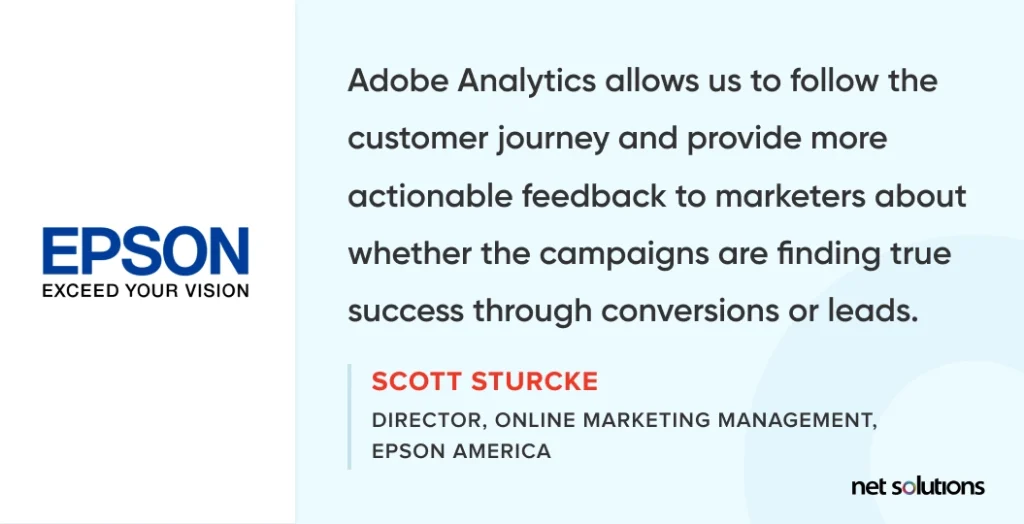
Frequently Asked Questions
The following are three levels of digital customer experience:
- Psychological: At this level, we develop empathy and a basic level of understanding toward our customers.
- Technical: At this level, we determine how to use data and technology to solve customers’ problems. It also involves tearing apart silos to establish cross-department collaboration.
- Experiential: At this level, we create unique experiences after understanding who they are and what they are looking for.
Team, tools, process, and feedback are the four key pillars of the digital customer experience.
Compensation, Culture, Communication, Compassion, and Care are the 5Cs of customer experience.
Digital experience optimization is the process of understanding customers and optimizing customer experiences in such a way that they get the best experience across all touchpoints.

